The Keys of Biosimilars to go Mainstream — from the Patients' Perspective
Biopharmaceutical, or biologic medical products, are anticipated to be an effective medicine in treating diseases that conventional drugs are not sufficient for cure. Although they have the advantages of high therapeutic efficacy, fewer side effects, and a wide range of applicable diseases, they are harder to manufacture and become more costly than some conventional drugs (small-molecule drugs). Correspondently, there are generic versions, such as with conventional drugs — called biosimilars . Biosimilars have the same or similar efficacy and safety as preceding biopharmaceuticals, while the price is set to 70% of the original, in general. They are available for certain diseases such as psoriasis, rheumatoid arthritis, and diabetes. In December 2021, the first biosimilar for treating age-related macular degeneration (AMD) entered the market.
According to the September 2021 Drug Price Survey, the current share of generic drug usage is 79% in Japan. The Ministry of Health, Labour and Welfare of Japan has set a target goal of that usage share to be over 80% in all prefectures by the end of FY2023. On the other hand, the rate of biosimilar usage tends to be lower than that of generic drugs, at 32.5% in FY2016 — less than half of generic drugs.
In March 2022, Nikkei Research conducted a survey targeting patients receiving treatment with biopharmaceuticals to investigate their current treatment issues, as well as the awareness and usage of biosimilars. Responses from a total of 400 patients (100 each for age-related macular degeneration, psoriasis, rheumatoid arthritis, and diabetes) were collected.
Financial burden is the top issue for patients using biosimilars
The respondents answered a multiple-select question about problems they are facing in continuing the treatment of their disease.
Across all disease types, "heavy financial burden" was significantly high, especially in psoriasis. This issue is particular from the patients' perspective when they want to continue to use biopharmaceuticals for their treatment. Other than the financial issue, "uncomfortable with injection" and "not feeling efficiency of treatment" were also cited. (Figure 1)
More than 90% of the patients who answered that they have a financial burden are paying more than 10,000 yen per month. Which is significantly different from those who did not answer financial burden as one of their problems. (Figure 2)
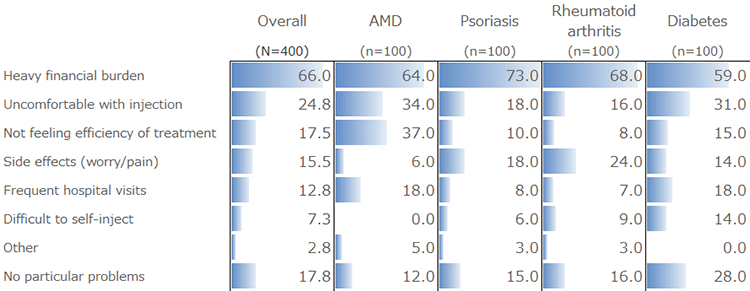
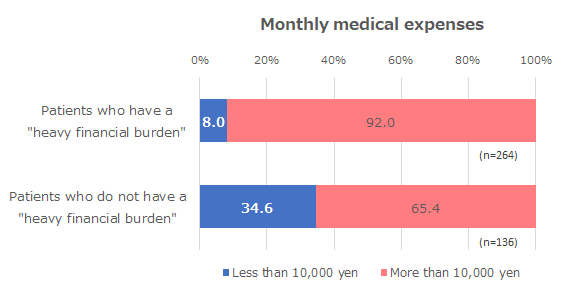
Awareness of biosimilars is less than 30% in patients using biopharmaceuticals
Among current patients using biopharmaceuticals, less than 30% of them know about biosimilars. Raising awareness is a big concern.
More than 80% of patients with age-related macular degeneration said they do not know about biosimilars, making them the least aware segment among the 4 diseases surveyed. The highest percentage of patients who use biosimilars were patients with rheumatoid arthritis, with over 10%. While only 2% of patients with age-related macular degeneration use biosimilars, awareness and usage widely differ by disease type. (Figure 3)
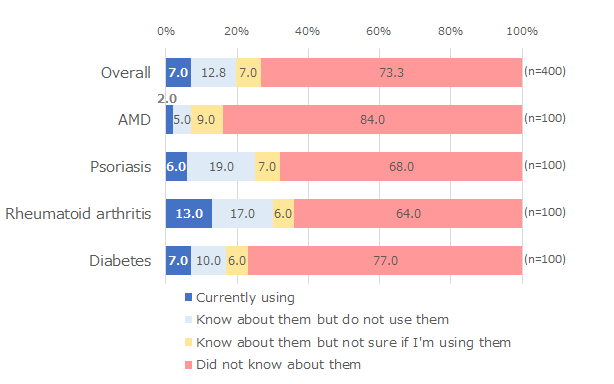
Over half of patients intend to use biosimilars. Alleviating the financial burden is the key
After when the features of biosimilars were presented — “Have the same efficacy and safety to those of prior biopharmaceuticals, and price of 70% of that of biopharmaceuticals with its patent expired” — more than 50% of the respondents preferred to use biosimilars. (Figure 4)
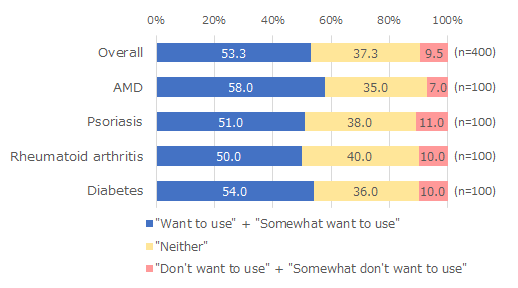
Looking at the reasons for the willingness to use biosimilars from an open-ended question, most patients mentioned that they look forward to cutting their treatment spends. In addition, patients who do not receive certain refunds from the high-cost medical care aid, have higher intentions of using biosimilars. Easing the patients' financial burden is an attractive feature.
The intention to use biosimilars was slightly higher in patients with age-related macular degeneration than in others. Moreover, among patients with age-related macular degeneration who do not apply for high-cost medical care aid, up to nearly 70% showed the willingness to use biosimilars. The price of biopharmaceuticals for treating age-related macular degeneration is higher than for other diseases, so the pricing advantage is significant. There should be a high demand in this group for using biosimilars. (Figure 5)
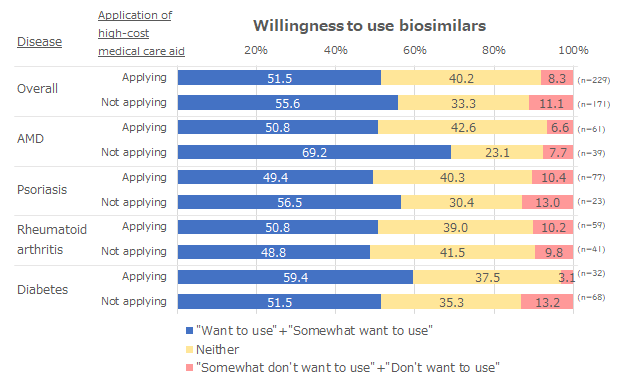
On the other hand, about 40% answered "neither" to the willingness to use biosimilars. Considering the weak awareness of biosimilars (Figure 4), patients may not have enough understanding to decide on the use of biosimilars in the first place.
Physicians play a key role — as the source of information and trigger the utilization of biosimilars
Around 90% of the respondents usually get information about diseases from their doctors, the main source for patients (Figure 6). The most common source of information on biosimilars is also doctors (Figure 7), with the major reason for using biosimilars to be advised by their doctors (Figure 8).
On the flip side, the main reason for not using biosimilars is the lack of doctors' recommendations (Figure 9). From making aware to the actual utilization of biosimilars, physicians play a key role throughout the entire process.
Besides doctors, the second most frequently used information source is websites that have information on diseases. (Figure 6, 7)
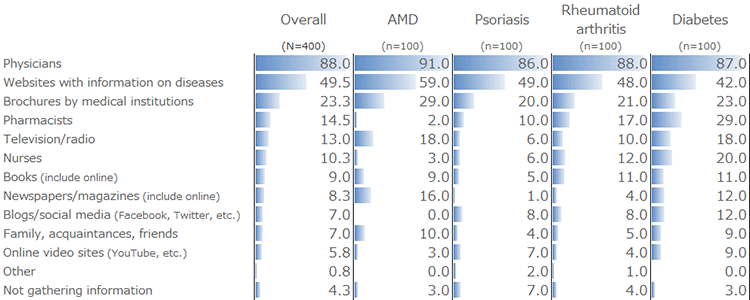
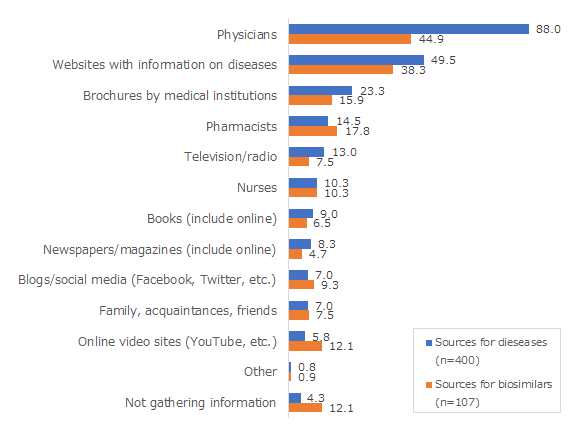
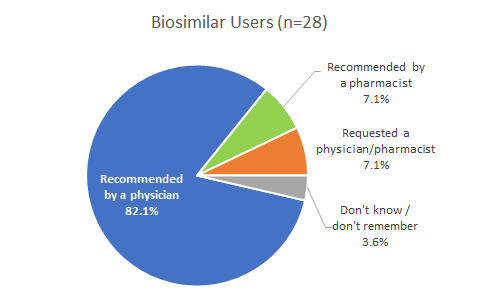
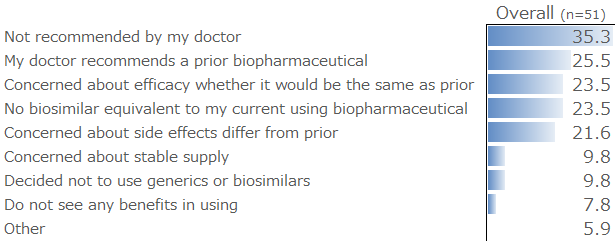
Lack of physician’s recommendation and concerns over the drugs are reasons for hesitation in using biosimilars
We checked the reasons for not wanting to use biosimilars of those who did not show the willingness to use them even after presenting the example case of reduced out-of-pocket expenses. The most common reason was not having recommendations from their doctor, with over 30%. Concern over the drug itself was also expressed by more than a quarter of the total. There were 20% of people who did not feel the benefit of the difference in price. (Figure 10)

More than 30% of patients are likely to use biosimilars if their doctor recommends them. Indicating that, the penetration largely weighs on the doctor’s encouragement to patients.
In every disease case, the likelihood of using biosimilars would increase by the doctor’s recommendation, but patients with psoriasis showed distinct characteristics compared to others, having strong anxiety toward biosimilars and not feeling beneficial in the price difference.
Conclusion: Promoting the use of biosimilars is important for both patients and physicians
The results indicate that while the financial burden is the current top issue of continuous treatment using biopharmaceuticals for patients with age-related macular degeneration, psoriasis, rheumatoid arthritis, and diabetes, many patients are unaware of biosimilars’ pricing advantages. The study also found that physicians play an important role thoroughly from making aware to bringing in the use of biosimilars.
Generally, physicians are the key to making patients know about biosimilars. This survey targeted the patients and not physicians, so we cannot determine, but it may be necessary to further improve the awareness and understanding of biosimilars on the physicians' side.
Biosimilars are expected to contribute not only to reducing healthcare costs, but they may also become a solution for patients who are hesitating to reach out to biopharmaceuticals for financial reasons.
To increase the usage of biosimilars, approaching both patients and physicians is essential. Especially for medical practitioners, educational activities (including drug adoption by medical facilities) and promotions by the government and pharmaceutical manufacturers are necessary.
Survey design
Targets and numbers:
Patients using biopharmaceuticals for the following diseases.
- Age-related macular degeneration: 100 patients
- Psoriasis: 100 patients
- Rheumatoid arthritis: 100 patients
- Diabetes: 100 respondents
The overall value shown in the figures is the combined average of patients across 4 diseases covered in this survey. It does not represent the actual total number of all biosimilar users in the market.
| Survey period | March 7-14, 2022 |
|---|---|
| Sampling source | Registered panels of our partners |
| Survey method | Online survey |
please contact us below.

